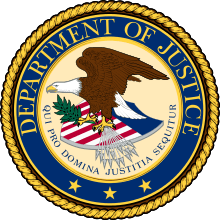United States Department of Justice Antitrust Division
| Competition law |
|---|
 |
| Basic concepts |
| Anti-competitive practices |
| Enforcement authorities and organizations |
The United States Department of Justice Antitrust Division is a law enforcement agency responsible for enforcing the antitrust laws of the United States. It shares jurisdiction over civil antitrust cases with the Federal Trade Commission (FTC) and often works jointly with the FTC to provide regulatory guidance to businesses. However, the Antitrust Division also has the power to file criminal cases against willful violators of the antitrust laws. The Antitrust Division also works with competition regulators in other countries.
Leadership
The head of the Antitrust Division is an Assistant Attorney General for Antitrust (AAG-AT) appointed by the President of the United States. The current Assistant Attorney General is Makan Delrahim.
History
On February 25, 1903, Congress earmarked $500,000 for antitrust enforcement. On March 3, 1903, Congress created the position of Antitrust AG, with a salary to be paid out of the funds earmarked for antitrust enforcement. The 1904 DOJ Register identified two professional staffers responsible for enforcement of antitrust laws, but it wasn't until 1919 that the Division was formally established. AG A. Mitchell Palmer “effected the first important reorganization" of DOJ since it was first established in 1870. Palmer organized DOJ into divisions, and placed the AtAG “in charge of the Anti-Trust Division.” Palmer's annual report for the fiscal year ending June 30, 1919 contained the first public statement that DOJ had a component called the "The Antitrust Division." [1]
Organization
The Antitrust Division is overseen by an Assistant Attorney General. The Assistant Attorney General is assisted by six Deputy Assistant Attorneys General (DAAG) who each oversee a different branch of the Division. One of the DAAGs holds the position of "Principal Deputy," that is "first among equals," and "will typically assume the powers of the Assistant Attorney General in the Assistant Attorney General’s absence."[2]
Sections and Offices
Front Office and Operations
Office of the Assistant Attorney General
- Assistant Attorney General
- Deputy Assistant Attorneys General
- Chief of Staff and Senior Advisors
- Directors of Enforcement
- Office of the Chief Legal Advisor
Civil Sections
- Defense, Industrials, and Aerospace Section
- Healthcare and Consumer Products Section
- Media, Entertainment, and Professional Services Section
- Technology and Financial Services Section
- Telecommunications and Broadband Section
- Transportation, Energy, and Agriculture Section
Criminal Sections and Offices
- Chicago Office
- New York Office
- San Francisco Office
- Washington Criminal I Section
- Washington Criminal II Section
Economic Sections
- Economic Analysis Group
Other Offices
- Appellate Section
- Executive Office
- Foreign Commerce Section
- Legal Policy Section
Closing of Field Offices
The closure of four of the Antitrust Division's criminal antitrust offices in January 2013 generated significant controversy within the Division and among members of Congress.[3][4][5] The Attorney General posited that the closure of these offices will save money and not negatively affect criminal enforcement. A significant number of career prosecutors have voiced contrary opinions, noting that the elimination of half of the Division's criminal enforcement offices will increase travel expenses and diminish the likelihood of uncovering local or regional conspiracies.
See also
- Competition Bureau — Canadian counterpart
References
- ↑ Gregory J. Werden, Establishment of the Antitrust Division of the U.S. Department of Justice
- ↑ Antitrust Division Manual. U.S. Dep't of Justice. April 2015. pp. I–4.
- ↑ "DOJ's Antitrust Plans Unclear Amid Looming Office Closures - Law360". www.law360.com. Retrieved 2017-01-28.
- ↑ "Kohl Urges DOJ To Reconsider Antitrust Office Closings - Law360". www.law360.com. Retrieved 2017-01-28.
- ↑ "DOJ Faces Mounting Flak Over Plan To Close Antitrust Offices - Law360". www.law360.com. Retrieved 2017-01-28.
